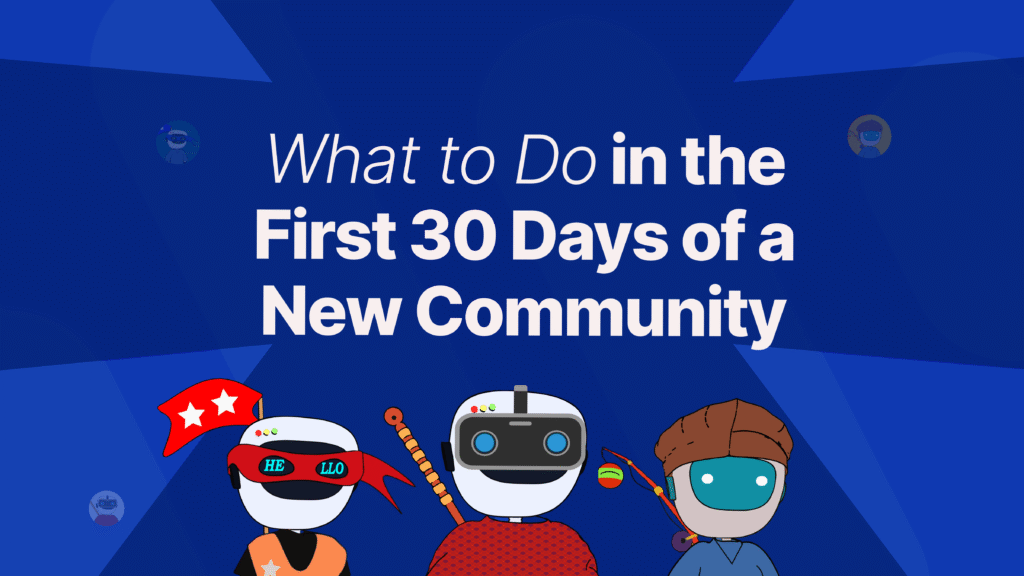Starting a new community feels like hosting a party where you’re not sure if anyone will show up. You’ve got the platform ready, maybe a few initial members, but now what?
The first 30 days are absolutely critical—they set the tone for everything that follows. Infact, the difference between communities that flourish and those that fizzle out often comes down to what happens in those early days when everything feels uncertain and overwhelming.
In this article, we’re diving into 8 essential strategies that will help you transform those first weeks into a solid foundation for long-term community success.
1. Set crystal clear expectations from day one
Your community members need to know what they’re signing up for. Think of it like moving into a new neighborhood—people want to understand the vibe, the rules, and what makes this place special before they start unpacking their bags.
Create a simple welcome post that explains your community’s purpose, what members can expect to find here, and how they can contribute. Don’t write a novel—just be clear and straightforward.
For example, if you’re building a community for freelance designers, say something like:
Make your community guidelines visible and easy to understand. Skip the legal jargon and focus on the behavior you want to see.
Instead of writing No spam or promotional content, try something like:
“Share your wins and resources, but keep it helpful rather than sales-y. If you’re not sure whether something belongs here, ask yourself: does this help other designers or just promote my business?|
2. Create your first pieces of valuable content
Empty communities feel awkward, like showing up to a party where no one’s talking. Your job is to break the ice and show people what good community participation looks like.
Start with content that directly addresses your members’ biggest challenges. If you’re targeting startup founders, create a post about common fundraising mistakes. If it’s a fitness community, share a simple workout routine that doesn’t require equipment. The key is making it immediately useful.
Don’t wait for members to create content—lead by example. Share your own experiences, ask thoughtful questions, and respond to every single comment in those early days. When people see you actively participating and adding value, they’ll feel more comfortable doing the same.
3. Identify and personally welcome your early champions
Your first few members are golden. These are the people who believed in your vision before anyone else did, and they’re going to be crucial in setting the community’s culture and attracting others.
Reach out to each early member personally. Send them a direct message thanking them for joining and asking what they hope to get out of the community. This serves two purposes: it makes them feel valued, and it gives you insight into what your community needs to provide.
Pay attention to who’s engaging early and often. These natural contributors are your future community leaders, so nurture these relationships. Feature their contributions, ask for their input on community direction, and make them feel like partners in building something special.
4. Host your first live interaction within the first week
Nothing builds community faster than real-time interaction. Whether it’s a video call, a live Q&A, or even a simple chat session, getting people together synchronously creates bonds that asynchronous posting just can’t match.
Keep your first live event small and low-pressure. A simple introduction round where everyone shares their name, what they do, and one thing they’re working on can be incredibly powerful. People remember faces and voices much better than usernames and profile pictures.
Follow up immediately after the event with a recap and photos if possible. This shows people who missed it what they’re missing and gives attendees content to share with their networks.
5. Establish consistent communication rhythms
Consistency builds trust, and trust builds community. Decide on a posting schedule that you can actually maintain and stick to it religiously.
This might mean a weekly discussion thread, a Monday motivation post, or Friday wins sharing. Whatever you choose, make it predictable so members know when to expect fresh content and interaction opportunities.
Create templates for recurring posts to make this easier on yourself. For example, if you do weekly check-ins, have a standard format like:
“What’s one thing you accomplished this week? What’s one challenge you’re facing? How can the community help? This gives people a clear framework for participation.”
6. Facilitate meaningful connections between members
Your community shouldn’t just be a place where people talk to you—it should be where they discover and connect with each other. This is where the real magic happens.
When you notice members with complementary skills or similar challenges, introduce them directly. Don’t just hope they’ll find each other—make it happen. Send a message like:
“Hey Sarah and Mike, you both mentioned struggling with client communication. Sarah just shared a great strategy in yesterday’s post that might help with your situation, Mike. You two should definitely connect!”
Create opportunities for members to help each other. Start a monthly thread where people can share what they’re working on and what kind of help they need. When someone asks a question, tag specific members who might have relevant experience instead of just hoping someone will respond.
7. Gather feedback and iterate quickly
Your community won’t be perfect from day one, and that’s completely normal. The key is listening to your members and making adjustments based on what you learn.
Ask direct questions about what’s working and what isn’t. Create a simple feedback form or just post a question asking members what they’d like to see more of. Pay attention to what content gets the most engagement and what falls flat.
Be transparent about changes you’re making based on feedback. When you add a new feature or change how something works, explain why. This shows members that you’re listening and that their input matters.
8. Document your wins and learn from what doesn’t work
Keep track of what’s happening in your community during these first 30 days. Note which posts get the most engagement, which members are most active, and what types of content or events generate the most enthusiasm.
Create a simple spreadsheet tracking key metrics like new member growth, post engagement, and active participants. This isn’t about obsessing over numbers—it’s about understanding what resonates with your community so you can do more of it.
Don’t just focus on successes. When something doesn’t work (and things won’t work), figure out why. Was the timing wrong? Was the content not relevant? Did people not understand what you were asking of them? These insights are just as valuable as celebrating your wins.
Shameless plug: why Coloniz makes building communities easier
Managing all these moving parts can feel overwhelming, especially when you’re trying to build something new. That’s exactly why we built Coloniz—to handle the technical complexity so you can focus on what really matters: creating value and fostering connections.
Unlike traditional platforms that make you juggle multiple tools for different functions, Coloniz gives you everything in one place. You can host both open welcome events and exclusive member-only discussions without switching platforms or losing track of conversations.
The integrated crypto wallet system means you can easily reward your most helpful members, collect donations for community initiatives, or even set up paid expert sessions—all without dealing with external payment processors or complicated logistics.
Most importantly, the community pot feature lets your members contribute to shared goals and fund things that benefit everyone. Imagine being able to crowdfund guest speakers, community meetups, or even just thank the members who consistently help others, all seamlessly within your community platform.
Your first 30 days are about laying the foundation for something bigger than yourself. With the right approach and tools, you can create a community that doesn’t just survive but thrives and grows into something truly special.
Ready to build the community you’ve been dreaming about? Get started with Coloniz today at www.coloniz.xyz .

